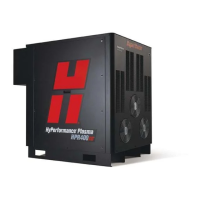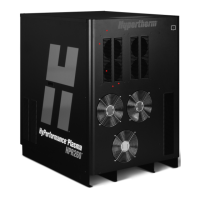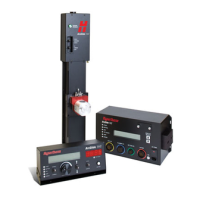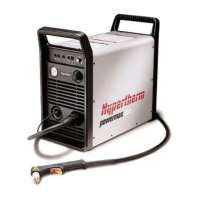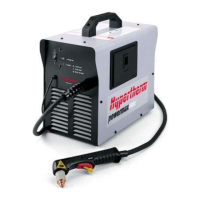How to fix flow switch failure in Hypertherm HT4400 Cutter?
- TTimothy CooperSep 8, 2025
To resolve a flow switch failure in your Hypertherm Cutter, replace the flow switch.
How to fix flow switch failure in Hypertherm HT4400 Cutter?
To resolve a flow switch failure in your Hypertherm Cutter, replace the flow switch.
What to do if HOLD input active for more than 30 seconds in Hypertherm Cutter?
If the HOLD input is active for more than 30 seconds on your Hypertherm Cutter, verify that the controller is not outputting a HOLD signal. See wiring diagrams for details.
Why paralleled system not releasing HOLD in Hypertherm HT4400 Cutter?
If a paralleled system is not releasing HOLD on your Hypertherm Cutter, disconnect the hold cable from other plasma power supplies and check the wiring of the hold circuit.
What to do if Hypertherm HT4400 was powered up while START command was coming from CNC?
If your Hypertherm Cutter system was powered up while a START command was coming from the CNC, remove the START signal. The system will then wait for the next START command.
What to do if Hypertherm HT4400 was turned on with HOLD signal active?
If the system was turned on with the HOLD signal active on your Hypertherm Cutter, remove the HOLD signal.
| Model | HT4400 |
|---|---|
| Type | Plasma Cutter |
| Open Circuit Voltage | 300 V |
| Input Phase | 3-Phase |
| Output Current | 40 A |
Identifies potential hazards using symbols and provides instructions to avoid them.
Emphasizes reading all safety messages and labels, maintaining labels, and proper operation.
Details fire prevention and explosion prevention measures for plasma cutting operations.
Outlines precautions to prevent electric shock, including proper grounding and insulation.
Warns about toxic fumes, recommending ventilation and respirators for safe cutting.
Describes the risks of plasma arcs causing injuries and burns, with safety tips.
Explains eye and skin protection against plasma arc rays, including lens shade recommendations.
Details proper grounding procedures for work cables and tables for safety and EMI prevention.
Provides safety guidelines for handling compressed gas cylinders, regulators, hoses, and fittings.
Explains the meaning of symbols and text on the machine's warning label for safe operation.
Lists and describes the main components of the HT4400 system, such as power supply and torch.
Specifies the types of gases and quality required for plasma cutting operations.
Details the specifications of the power supply, including voltage, current, and dimensions.
Provides specifications for the machine torch, including cutting capability and dimensions.
Lists specifications and mounting dimensions for the gas console unit.
Provides specifications and mounting recommendations for the ignition console.
Details specifications for the water cooler, including dimensions, capacity, and flow rate.
Lists specifications and mounting dimensions for the optional remote current control console.
Outlines general requirements for electrical and plumbing system installation by qualified personnel.
Details gas supply requirements, including regulator type, pressure, and purity.
Details the recommended coolant mixture and requirements for the torch coolant system.
Explains the importance of proper grounding for safety and EMI prevention, referencing appendix A.
Details electrical power requirements, including input voltage, current, and cable sizing.
Details the procedure for connecting the main power supply, including safety precautions.
Provides a diagram and references for connecting system components like ignition, gas, and water cooler.
Details how to connect the torch to the torch leads, including lubrication.
Provides instructions for mounting and aligning the torch to the workpiece.
Guides through the initial startup procedure after installation, including coolant flow checks.
Provides an overview of the controls and indicators on the gas console.
Explains the function of each control and indicator on the gas console.
Lists and explains error codes and status messages displayed on the gas console.
Provides procedures for performing leak tests on the plasma and shield gas systems.
Outlines the steps for daily startup, including checking torch and consumables.
Identifies common cutting problems, their causes, and potential solutions.
Presents performance data for cutting mild steel with oxygen plasma, including pressures and kerf width.
Offers advice on improving cut quality through proper cut angle, dross control, and surface smoothness.
Provides tips for extending the life of consumable parts, including adherence to LongLife procedures.
Refers to the preventative maintenance schedule for routine maintenance recommendations.
Details the procedure for replacing the water cooler filter element.
Outlines the steps for cleaning the pump strainer.
Provides a procedure for draining torch coolant for maintenance or transportation.
Illustrates the system startup sequence flow chart from power on to idle state.
Shows the sequence flowchart from plasma START signal to RUN state.
Presents the sequence flowchart from RUN state through the end of a cut.
Provides a table of error codes, their possible causes, and solutions for troubleshooting.
Offers troubleshooting steps for various system issues, categorized by condition and result.
Guides on performing initial visual checks and voltage verification before detailed troubleshooting.
Provides a step-by-step procedure for testing chopper modules using a multimeter.
Outlines the procedure for testing the coolant flow rate of the system.
Specifies the settings for the plasma and shield pressure switches (PG1 and PG2).
Provides a schedule for daily, weekly, monthly, bi-annual, and annual preventative maintenance tasks.
Lists parts for the Power Supply, Front Panel Outside, with item numbers and descriptions.
Lists parts for the Ignition Console, including the main unit, filters, and inductor.
Lists parts for the Gas Console, including toggle switches, pressure switches, and PCB.
Lists parts for the Water Cooler, including fans, pump, filter, and hoses.
Lists parts for the HT4400 Torch assembly, including adapters, consumables, and torch body.
Shows configurations of consumables (retaining cap, nozzle, swirl ring, electrode) for different materials and settings.
Lists recommended spare parts for the Power Supply and Ignition Console.
Explains the organization and referencing format used in the wiring diagrams section.
Provides a key to the various symbols used in the wiring diagrams.
Details requirements for grounding the plasma system for safety and EMI suppression.
Provides guidance on routing ground cables for the power supply and equipment.
Explains grounding procedures for accessory modules and the work table.
Details grounding requirements for the worktable, including supplementary ground rods and ferrite chokes.
Contains safety data for propylene glycol, covering identification, hazards, and handling.
Provides safety data for benzotriazole, including its properties, hazards, and regulatory status.
Discusses the importance of quality gas regulators and lists available Hypertherm models.
Lists noise level measurements for the HT4400 system under various operating conditions.
Provides cutting parameters for Mild Steel at 400 Amps using O2/N2 shield gas at 140 PSI.
Provides cutting parameters for Mild Steel at 300 Amps using O2/N2 shield gas at 140 PSI.
Provides cutting parameters for Mild Steel at 200 Amps using O2/N2 shield gas at 140 PSI.
Provides cutting parameters for Mild Steel at 100 Amps using O2/N2 shield gas at 140 PSI.
Provides cutting parameters for Stainless Steel at 400 Amps using N2/N2 shield gas at 140 PSI.
Provides cutting parameters for Stainless Steel at 200 Amps using N2/O2-N2 shield gas at 140 PSI.
Provides cutting parameters for Aluminum at 400 Amps using N2/N2 shield gas at 140 PSI.
Provides cutting parameters for Aluminum at 200 Amps using N2/O2-N2 shield gas at 140 PSI.
Provides cutting parameters for Mild Steel at 400 Amps using O2/N2 shield gas at 120 PSI.
Provides cutting parameters for Mild Steel at 300 Amps using O2/N2 shield gas at 120 PSI.
Provides cutting parameters for Mild Steel at 200 Amps using O2/N2 shield gas at 120 PSI.
Provides cutting parameters for Mild Steel at 100 Amps using O2/N2 shield gas at 120 PSI.
Provides cutting parameters for Stainless Steel at 400 Amps using N2/N2 shield gas at 120 PSI.
Provides cutting parameters for Stainless Steel at 200 Amps using N2/O2-N2 shield gas at 120 PSI.
Provides cutting parameters for Aluminum at 400 Amps using N2/N2 shield gas at 120 PSI.
Provides cutting parameters for Aluminum at 200 Amps using N2/O2-N2 shield gas at 120 PSI.


